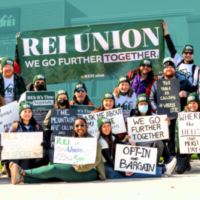Executive Summary
Amazon has not lived up to its promise of providing quality jobs to workers in the United States.[1] An analysis of the corporate giant’s operations in Minnesota illustrates how it fails to provide a safe workplace, stable employment, and adequate compensation to its workers, who are disproportionately Black and include many East African immigrants. As Amazon expands its footprint throughout the country and in Minnesota—with new facilities opening in 2021 around the state—an analysis of Amazon’s current warehouses in Minnesota reveals a range of grave concerns for workers, communities, and the public.[2] The authors of this report examined data from the U.S. Census, the Bureau of Labor Statistics, and the Occupational Safety and Health Administration for Amazon warehouses in Minnesota, with a particular focus on the two longest-standing Amazon facilities in the state, located in the Twin Cities suburb of Shakopee in Scott County. Key findings include the following:
- Extreme rates of injury. Amazon warehouse workers in Minnesota are more than twice as likely to be injured at work as other Minnesota warehouse workers. According to Amazon’s own records from 2018 to 2020, the rate of injuries at its Minnesota warehouse facilities is 11.1 cases annually per 100 full-time-equivalent workers. This is the equivalent of one injury for every nine workers each year—more than double the rate at non-Amazon Minnesota warehouses (5.2) and more than four times the average rate for all private industries in Minnesota (2.7) during the same period. The warehousing industry average (including Amazon) in Minnesota during that period was 7.0 cases annually per 100 full-time-equivalent workers.[3] In particular, Amazon’s flagship warehouse in Minnesota, the Shakopee fulfillment center, has consistently reported extremely high rates of injury. In 2020, no industry in Minnesota had a higher average injury rate than the Shakopee Amazon fulfillment center, as seen below in Figure 3.[4]
- Racial earnings gap and occupational segregation. Black workers are overrepresented in Scott County warehouses (which are mostly Amazon facilities), representing 38 percent of the warehousing workforce and only 8 percent of the total workforce in the Twin Cities.[5] (See Figure 1.) Additionally, Black warehouse workers’ monthly earnings are only 63 percent of white warehouse workers’ monthly earnings.[6] (See Figure 2.)
- Triple-digit turnover rates. Annual turnover at the Shakopee Amazon warehouses is as high as 170 percent. This means that for every job at the Shakopee Amazon facilities, almost two workers left their positions there over the course of a year. By contrast, turnover in Minnesota at non-Amazon warehouses was only about 61 percent.[7] (See Figure 4 and Table 1.)
- Wage decline in the warehouse sector. Real wages for warehouse workers in Minnesota declined over 14 percent between 2015 and 2018, the years after Amazon began operating from Shakopee, as reflected by the latest available Census data.[8] (See Figure 5.) As of 2018, Scott County warehouses (mostly Amazon) represented about a third of all warehouse employment in Minnesota.[9]
- Exploitation of seasonal and nonstandard workforce. Amazon uses seasonal and nonstandard work arrangements to erode labor standards and thwart worker organizing.[10]
- Costs to the public. Amazon breeds poverty in communities, even as it profits from a government program that provides nutrition assistance to people living in poverty. It diverts public dollars away from schools and libraries in order to finance roads and highways feeding its facilities. Traffic around Amazon facilities creates pollution that harms the health of Shakopee residents and contributes to climate change. And Amazon’s predatory pricing has contributed to the decline of competing retailers in Minnesota.[11]
The picture that emerges is a troubling one. Amazon has fueled its rapid growth by employing workers—many of them Black—in extremely dangerous jobs that pay inadequate wages and are not designed to provide long-term employment.[12] The relentless pace of work at Amazon warehouses—which the company enforces through its invasive electronic surveillance systems and harsh disciplinary practices—has had devastating impacts on these workers’ bodies.[13] And while Amazon expands its operations by undercompensating warehouse workers and pressuring them to work at unsafe speeds, the company’s profits have grown exponentially and reached new highs.[14]
Recently, Congress has begun taking important steps to rein in the growing monopoly power of Amazon, with Minnesota’s Senator Amy Klobuchar taking a lead role as chair of the Senate Judiciary antitrust subcommittee.[15] Amazon already dominates the warehouse sector in Minnesota, with Scott County warehouses representing about a third of total warehouse employment in the state.[16] As Amazon pursues further expansion in Minnesota, it is time for Minnesota’s state government to also take bold steps to respond to the negative impacts of Amazon’s growing operations and address the specific harms affecting Minnesotans who have toiled to make that growth possible.
We conclude the report with recommendations for state lawmakers and regulators that, if adopted, would mitigate some of the worst impacts of Amazon’s presence to date and lay the groundwork for the company to become a responsible employer that will truly help Minnesota thrive. To start, the State of Minnesota, the Minnesota Legislature, Minnesota OSHA, and other appropriate public agencies must take the following steps:
- Convene public hearings on Amazon’s presence in Minnesota;
- Launch a wall-to-wall Minnesota OSHA investigation of health and safety hazards in Amazon facilities;
- Mandate rest breaks and reasonable, transparent work-pace standards in the warehouse industry;
- Ban harmful and opaque surveillance and disciplinary policies such as “Time Off Task”; and
- Investigate and address occupational segregation and racial inequity at Amazon’s Minnesota operations.
By adopting these recommendations, Minnesota lawmakers and regulators can begin to mitigate the harm caused by Amazon and ensure that the company lives up to its promise to provide high-quality jobs and public benefit to the residents of the state.
Download the complete report to read more.
Endnotes
[1] Amazon.com, Inc. “Amazon Confirms Fulfillment Center in Shakopee Creating More than 1000 Full-Time Jobs.” June 18, 2015. Accessed October 5, 2021. https://www.businesswire.com/news/home/20150618006389/en/Amazon-Confirms-Fulfillment-Center-in-Shakopee-Creating-More-than-1000-Full-Time-Jobs
[2] This report addresses six Amazon warehousing facilities in Minnesota: MSP1, MSP5, MSP9, DMP1, CMN1, and HMS1.
[3] Occupational Health and Safety Administration “Establishment Specific Injury and Illness Data.” Accessed November 29, 2021. https://www.osha.gov/Establishment-Specific-Injury-and-Illness-Data. These figures refer to all cases requiring medical treatment, including serious cases that require transfer to light duty or days of missed work.
[4] Occupational Health and Safety Administration “Establishment Specific Injury and Illness Data.” Accessed November 29, 2021. https://www.osha.gov/Establishment-Specific-Injury-and-Illness-Data; and, Minnesota Department of Labor and Industry Research and Statistics Unit, Survey of Occupational Injuries and Illnesses. “Table 4. Incidence rates and numbers of nonfatal occupational injuries by selected industries, Minnesota, 2020.“ Accessed November 29, 2021. https://www.dli.mn.gov/our-areas-service/research-and-statistics/survey-occupational-injuries-and-illnesses
[5] U.S. Census Bureau Quarterly Workforce Indicators, 2018. See Methodological Note for more information.
[6] U.S. Census Bureau Quarterly Workforce Indicators, 2018.
[7] U.S. Census Bureau Quarterly Workforce Indicators, 2018.
[8] 2018 is the latest year of data available from the Census Bureau’s Quarterly Workforce Indicators for Scott County, Minnesota that reflects Amazon’s presence in that county. Beginning with the 2019 QWI data, data reported for Scott County show less than a hundred warehouse employees, suggesting that those data do not reflect Amazon’s workforce in the county. This may be a result of the Census Bureau’s confidentiality policies or it may be a result of changes in Amazon’s reporting practices.
[9] U.S. Census Bureau Quarterly Workforce Indicators, 2018.
[10] See section in report starting on page 20.
[11] See section in report starting on page 20.
[12] Tung, Irene and Debbie Berkowitz. “Amazon’s Disposable Workers: High Injury and Turnover Rates at Fulfillment Centers in California.” National Employment Law Project. March 2020. Accessed October 5, 2021. https://www.nelp.org/publication/amazons-disposable-workers-high-injury-turnover-rates-fulfillment-centers-california/
[13] Long, Katherine Ann and Will Evans. “Amazon’s relentless pace is injuring warehouse workers and violating the law, Washington state regulator says.” Seattle Times. May 25, 2021.
[14] In the period immediately after the Shakopee warehouses opened, from 2017 to 2019, Amazon’s profits grew rapidly, totaling roughly $24.7 billion, which were the highest profits in its history. Since the pandemic Amazon’s profits have grown even more dramatically. See Owens, Jeremy. Amazon’s pandemic profits top previous 3 years of earnings. Market Watch. April 29, 2021. Accessed October 5, 2021. https://www.marketwatch.com/story/amazon-has-made-as-much-profit-during-pandemic-as-previous-three-years-of-earnings-in-total-11619726844; and Amazon’s Profit Tripled in First Quarter, New York Times, April 21, 2021. Accessed October 5, 2021. https://www.nytimes.com/live/2021/04/29/business/stock-market-today
[15] Kang, Cecilia. “Democratic Congress Prepares to Take On Big Tech” New York Times. January 26, 2021. Accessed October 5, 2021. https://www.nytimes.com/2021/01/26/technology/congress-antitrust-tech.html McKinnon, John and Julie Bykowicz. “Google, Facebook, Amazon Among Those Set to Fight House Big Tech Antitrust Package.” Wall Street Journal. June 24, 2021. Accessed October 5, 2021. https://www.wsj.com/articles/house-judiciary-committee-passes-final-piece-of-big-tech-antitrust-package-11624562811
[16] NELP analysis of U.S. Census Bureau Quarterly Workforce Indicators, 2018.
Related to
Related Resources
All resourcesWhen ‘Bossware’ Manages Workers: A Policy Agenda to Stop Digital Surveillance and Automated-Decision-System Abuses

Report
Delivering Precarity: How Amazon Flex Harms Workers and What to Do About It

Policy & Data Brief
REI Workers Speak Out: Racial Discrimination, Inequity, and the Fight for a Fair Workplace

Report


